
Copán is one of the three major Maya centers (besides Tikal in Guatemala and Chich'én Itzá in México). It has numerous structures and temples, much is in the surrounding forests, waiting to be excavated.
The main site of Copán is shown in the image map. Another site is at Las Sepulturas.
The Copán Stelae and the Maya ruler genealogy are described on separate pages.
All pictures are © Dr. Günther Eichhorn, unless otherwise noted.

Temple 1 is at the west side of the Plaza de las Estellas. It is not excavated. Stele E is located on Structure 1.

Temple 2 is at the north side of the Plaza de las Estellas. It is not excavated. Stele D is located on Structure 2.

Temple 4 is located in the Great Plaza at Copán. It is a single radial temple with 4 stairways, flat summit, and 4 terraced levels. It occupies the very center of the primary public space at Copán (dividing it in two somewhat smaller spaces) where the east and west causeways enter the Great Plaza - thus it is at the center of ritual space. Also at this place are two rows of stelae marking the end of the 15th k'atun of Maya history. All the monuments, Structure 4 and the associated stelae are the work of Waxaklajuun Ub'aah K'awiil (18 Rabbit), 13th ruler of Copán.
The dates on the stelae at Temple 4 countdown to the time of the end of the 15th k'atun. The Maya viewed a 4-fold structure for the temple cycle starting at a Long Count of 9.14.0.0.0 (the 5-year quarter k'atun wasn't marked here). Stele F marks the half k'atun cycle date; Stele 4 has the ¾ k'atun cycle. The other 3 stelae mark the final countdown. Stelae H, A, B, are dedicated within 260 days of each other and span the internal tzolk'in cycle that culminates on Long Count 9.15.0.0.0 - Aug. 18, 731 CE, the final day of time the stelae commemorate.
Stele H was dedicated on Long Count 9.14.19.5.0 - Dec. 1, 730 CE. The last stelae in this small group is Stele B; it marks the ending of the k'atun. The intermediate Stele A falls just before the middle of the k'atun ending period. This is the next to last monument dedicated by 18 Rabbit, dating to Long Count 9.14.19.8.12 - Jan. 30, 731 CE. It was dedicated 3 winals (=60 days) after Stele H and some 200 days before the cycle ending marked by Stele B. It has the longest text of the group and is the most revealing of rituals marking the k'atun ending. The 4 Ahaw ending dates for these monuments are similar to the day of creation itself. The Maya, as most other Mesoamerican civilizations, believed in a series of worlds created and destroyed by the Gods, beginning on Calendar Round 4 Ajaw 8 Kumk'u and this is mirrored by these stelae dates at Copán. 18 Rabbit seized on these cycles to make his monument grouping a symbolic recreation of the world where a ritual process could happen recreating the creation of the world by the Gods.
Stele A is adjacent to Temple 4, its cruciform foundation overlapping the temples northern foundation that is associated with 18 Rabbit. He added 2 stairways, making it 4 directional in plan in anticipation of the 15 k'atun ending. In all probability, the Stelae and Temple 4 were closely related The inscription on Stele A outlines the erection of the monument on the date of Calendar Round 12 Ajaw 18 Kumk'u, the month period is also 1 day before the end of the solar year. It represents the convergence of several cycles at that time with the iconography predominantly a solar theme. The inscription continues on the west side, with the erection of the monument, its name - The Great Sun (solar deity), then a distance number of 60 days (3 winals). It continues with the dedication date of Stelae H (Calendar Round 4 Ajaw 18 Muwan') which began the tzolk'in cycle. It then gives us the name of Stele H, then launches into a very interesting passage. This passage tells what rituals 18 Rabbit performed in the 60 day tzolk'in division between Stelae H and A. It concerns the death, afterlife, and rites of veneration of an ancestral ruler - Cauc Chan or Fire Serpent.



Temple 8 is located on the north-west corner of the Acropolis area.
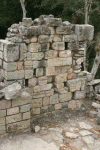

Temple 9 is the west part of the Ball Court.




Structure 10 is the east part of the Ball Court.



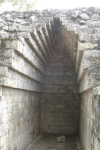



Temple 11 is at the north end of the Acropolis West Court.


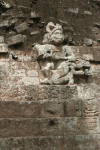


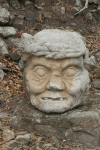




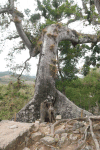
Temple 16 is located in the Acropolis in Copán. It was built by the the 16th ruler of Copán, Yax Pasaj Chan Yoaat or Yax Pac, completed in 776 CE. Structure 16 was build over a previous temple, the Rosalila Temple. This temple was not destroyed, it was ceremoniously covered intact. The Rosalila structure was found only in 1989. It had been built by the 10th ruler of Copán, Moon Jaguar.
In front of Structure 16 is the famous Altar Q.




Structure 18 is located on the south-east corner of the Acropolis. It dates to 820 CE, the end of the Maya dynasty in Copán.

Structure 19 is located on the east side of the Acropolis.

The major architectural accomplishment of Ruler 13 was perhaps Temple 22, atop a large platform to the north of the East Court. This temple was conceived as the model of the primordial maize-sprouting mountain (wits) of Maya cosmology. Today most of its decorative sculpture lies in jumbled piles, but enough remains on the structure to make the identification secure. Large masks of the animated mountain spirit adorned each corner, and several large figures of the Maya maize were excavated from the ruins here before the turn of the century. Within the mountain-temple was an inner chamber, the door to which was itself sculpted with an image of the Maya night sky, with the Milky Way shown as an arching "cloud serpent." The step to this doorway bore a hieroglyphic text -- now lost -- that is one of the most extraordinary to have come down to us from all Maya sites. Its special qualities come not from what it says, but how it states its subject. It begins with the sentence: "On the day 5 Lamat is the completion of my k'atun (in office)." The k'atun is a period of roughly twenty years in the Mayan calendar, and the day five Lamat tells us that this is the twentieth year anniversary of Ruler 13's accession to the throne. The date of the building is thus clearly established to have been constructed at or around March 27, 715 CE. But notice here the use of the first person voice, "my first k'atun." These are the spoken words of Ruler 13 himself, and constitute the only known example of a quotation of an ancient Maya king.
We know now that by raising Structure 22, 18 Rabbit was re-creating a type of structure that had been built many time before by his ancestors, expressing their own special vision of Creation. This temple's last and most ambitious manifestation was constructed with mud mortar, a kind of construction that required constant and careful maintenance to ensure that its plaster seal did not leak and weaken the walls. Once no longer maintained, it deteriorated and collapsed. Today we have only fragments of the beautiful sculptures that once decorated it -- pieces found lying in the grass by the temple's feet -- but they are enough to help us contemplate the building's lost beauty and significance.
The replication of the cosmos in ceremonial architecture was one of the hallmarks of Mesoamerican architecture. The facade of Structure 22, toward the highest point of the Copán acropolis, faces south. The upper frieze of the temple reconstruction is carved into swirling volutes of celestial clouds, whose sky band is supported at both ends by the Pawahtun titans, as shown in one of the images. At the floor level several stone skulls appear, as if in the underworld. The entrance to Temple 22 is therefore, at the level of the earth, between the underworld and the sky
In front of the entrance are serpents fangs. The serpent was the most sacred animal of the Maya, the jaguar the second most sacred.






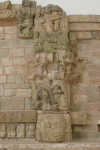

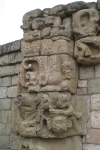
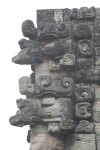

Temple 26 with the Hieroglyphic Stairway is just south of the Ball Court. In a whole city of grandiose art and architecture, the Hieroglyphic Stairway reigns supreme. This stairway climbs for 69 feet up the west side of Structure 26. Its construction was commissioned in two phases, the first by 18 Rabbit. Smoke Squirrel, one of 18 Rabbit's successors, ordered the construction of the complete staircase in 755. It is his portrait that appears in Stele M, standing at the bottom of the stairs. As visible in the larger image, portraits of originally six previous kings adorned the center of the stairway. The close-up shows the current condition of the glyphs that once lined the whole stairway. Remnants of red paint suggest that the stairs were also wholly painted.
Unfortunately much of the stairway had fallen down. The hieroglyphic inscriptions have been scrambled and are now unreadable. Only about 40% are in their original order.


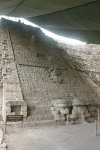
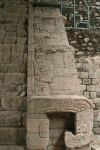


Structure 29 is located on the south side of the Acropolis, north of the Cemetery area.

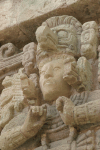
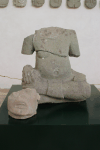

Temples 30 and 32 are located on the south side of the Acropolis, north of the Cemetery area.

While not the largest Ball Court of the Maya world (that honor goes to Chich'én Itzá), the Ball Court at Copán is monumental in its own right. It is in fact cataloged as Ballcourt A-III, and it was constructed after 18 Rabbit ordered the destruction of the previous Ballcourt A-IIb. This court was dedicated on January 6, 738, only three months before 18 Rabbit was seized by the rival Quirigua King K'ak' Tiliw Chan Yoaat and beheaded. Details of the ballcourt architecture in fact depict the king 18 Rabbit confronting one of the lords of the Underworld, whose arena the Ball Court represented. At least 16 birds appear in the court, including this exquisite stone macaw from the east wall, pictured in the right detail. The macaw's tail feathers bear the glyph for the day-sign akbal, "night."



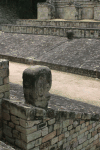
About 3 km (1.9 miles) south of Copán, halfway up the mountain, is a small Maya site with some sculptures carved out of the bedrock, called Los Sapos. It was a birthing site, where women would go to give birth.


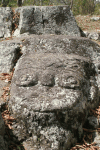
This page contains 63 pictures
Page last updated on Tue Sep 24 18:19:03 2019 (Mountain Standard Time)
Honduras - Temples in Copan on guenther-eichhorn.com